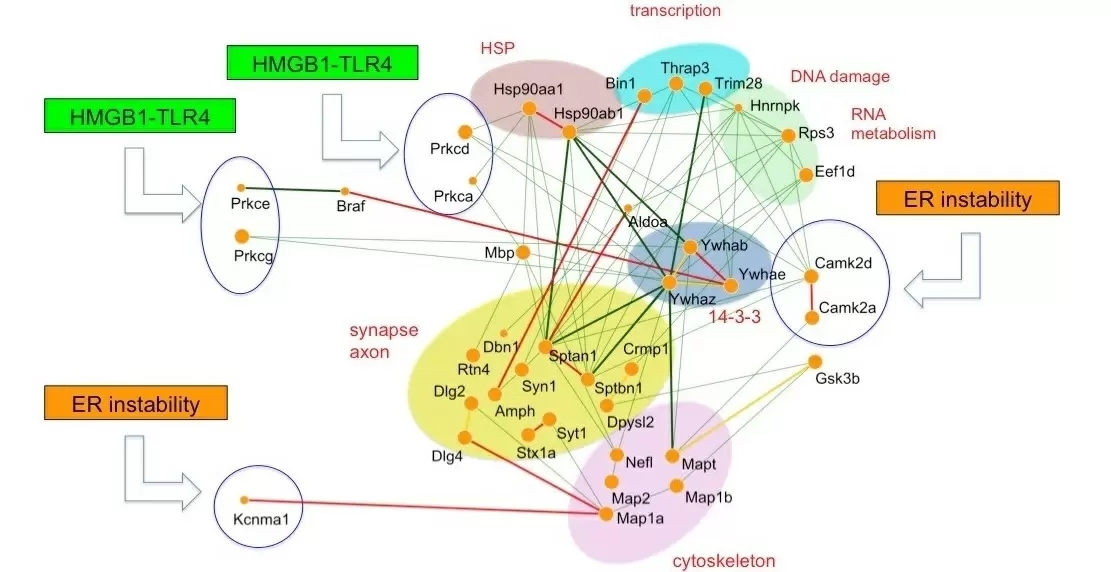Prediction and verification of the AD-FTLD common pathomechanism based on dynamic molecular network analysis (2021)
Dementia has many faces, and because of the wide range of ways in which it can develop and affect patients, it can be very challenging to treat. Now, however, using supercomputer analysis of big data, we have revealed that the protein HMGB1 is a key player in both frontotemporal lobar degeneration (FTLD) and Alzheimer disease (AD), two of the most common causes of dementia.
FTLD can be caused by mutation of a variety of genes, which means that no one treatment will be right for all patients. However, there are some similarities between FTLD and AD, which led us to explore whether these two conditions cause damage to the brain in the same way.
AD pathology and FTLD often coexist in the postmortem brain. Because of this overlap, we wanted to investigate wheter the molecular mechanisms of disease were also similar.
We used a sophisticated technique called molecular network analysis to take a snapshot of which proteins are expressed, and to what degree, in mice that had been genetically engineered to mimic AD and FTLD. Supercomputer analysis of these protein networks was performed in mice of different ages to capture a dynamic picture of how they changed over time.
The result was surprisingly clear that the core protein-protein interaction networks in AD and in FTLD were highly similar, sharing almost 50% of core proteins.
FTLD can be caused by mutation of a variety of genes, which means that no one treatment will be right for all patients. However, there are some similarities between FTLD and AD, which led us to explore whether these two conditions cause damage to the brain in the same way.
AD pathology and FTLD often coexist in the postmortem brain. Because of this overlap, we wanted to investigate wheter the molecular mechanisms of disease were also similar.
We used a sophisticated technique called molecular network analysis to take a snapshot of which proteins are expressed, and to what degree, in mice that had been genetically engineered to mimic AD and FTLD. Supercomputer analysis of these protein networks was performed in mice of different ages to capture a dynamic picture of how they changed over time.
The result was surprisingly clear that the core protein-protein interaction networks in AD and in FTLD were highly similar, sharing almost 50% of core proteins.
Further analysis of these core protein nodes predicted that signaling through HMGB1, which is a critical factor in AD, also plays a key role in FTLD. Importantly, this result was confirmed by the researchers, who found that treating mice with FTLD with an antibody to HMGB1 improved their long-term memory, short-term memory, and spatial memory.
This method successfully predicted and identified HMGB1 as a key target for treating patients who have dementia due to FTLD, regardless of the genetic basis of the disease.
Given the fact that the mice recovered their memory after several months of treatment with the anti-HMGB1 antibody, it is possible that treatments targeting this protein could actually reverse damage in patients with FTLD. Because similar molecular changes are seen in many different types of dementia, a treatment based on this antibody could be effective in a wide range of patients.
This method successfully predicted and identified HMGB1 as a key target for treating patients who have dementia due to FTLD, regardless of the genetic basis of the disease.
Given the fact that the mice recovered their memory after several months of treatment with the anti-HMGB1 antibody, it is possible that treatments targeting this protein could actually reverse damage in patients with FTLD. Because similar molecular changes are seen in many different types of dementia, a treatment based on this antibody could be effective in a wide range of patients.

The core molecular network shared by Alzheimer's disease and frontotemporal lobar degeneration.
Supercomputer-based dynamic molecular network analysis predicted HMGB1-TLR4 induced signal as the most important target of two major neurodegenerative dementias. The prediction was verified by significant phenotypic and pathological improvements of four types of mouse model of frontotemporal lobar degeneration treated by anti-HMGB1 antibody.
Publications
Jin, M., Jin, X., Homma, H., Fujita, K., Tanaka, H., Murayama, S., Akatsu, H., Tagawa, K. & Okazawa, H. (2021)
Prediction and verification of the AD-FTLD common pathomechanism based on dynamic molecular network analysis.
Commun. Biol. 4 12 August 2021 (1), 961. doi: 10.1038/s42003-021-02475-6
Prediction and verification of the AD-FTLD common pathomechanism based on dynamic molecular network analysis.
Commun. Biol. 4 12 August 2021 (1), 961. doi: 10.1038/s42003-021-02475-6

